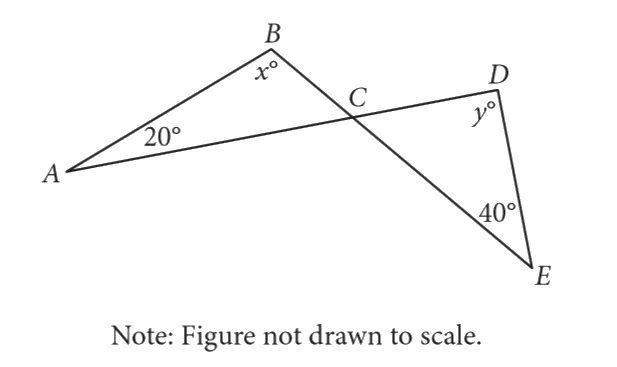
In the figure above, ¯¯¯¯¯¯AD intersects ¯¯¯¯¯¯BE at C. If x = 100, what is the value of y ?
100
90
80
60
The correct Answer is:C
It’s given that x = 100, therefore, substituting 100 for x in triangle ABC gives two known angle measures for this triangle. The sum of the measures of the interior angles of any triangle equals 180∘. Subtracting the two known angle measures of triangle ABC from 180∘ gives the third angle measure: 180∘−100∘−20∘=60∘. This is the measure of angle BCA. Since vertical angles are congruent, the measure of angle DCE is also 60∘. Subtracting the two known angle measures of triangle CDE from 180∘ gives the third angle measure: 180∘−60∘−40∘=80∘. Therefore, the value of y is 80.
Choice A is incorrect and may result from a calculation error. Choice B is incorrect and may result from classifying angle CDE as a right angle. Choice D is incorrect and may result from finding the measure of angle BCA or DCE instead of the measure of angle CDE.
Similar Questions
The inequation that best describes the following graph is _________
02:10View SolutionWhich inequations represent the shaded region in the given figure
04:23View SolutionIn Fig, find the value of x.
ltimg src="https://d10lpgp6xz60nq.cloudfront.net/physics_images/PS_MATH_IX_C12_S01_032_Q01.png" width="80%"gt01:13View SolutionIn the following figure, if O is the center of the circle and ¯¯¯¯¯¯AB is the diameter, then find ∠ACB.
ltimg src="https://d10lpgp6xz60nq.cloudfront.net/physics_images/PS_MATH_IX_C12_E02_009_Q01.png" width="80%"gt02:02View SolutionIn the given figure, ¯¯¯¯¯¯AD and ¯¯¯¯¯¯BE intersect at C, such that BC = CE, ∠ABC=40∘ and ∠DEC=85∘. Find ∠BAC−∠CDE.
ltimg src="https://d10lpgp6xz60nq.cloudfront.net/physics_images/PS_MATH_IX_C12_E04_027_Q01.png" width="80%"gt03:28View SolutionIn the given figure, PQRS is a parallelogram. A and B are the mid-point of ¯¯¯¯¯¯PQ and ¯¯¯¯¯SR respectively. If PS=BR, then the quadrilateral ADBC is a…………………… ,
ltimg src="https://d10lpgp6xz60nq.cloudfront.net/physics_images/PS_MATH_IX_C12_E05_020_Q01.png" width="80%"gt03:02View SolutionAt x=0, value of (dy)/(dx) is : ltimg src="https://d10lpgp6xz60nq.cloudfront.net/physics_images/ALN_PHY_R04_E01_024_Q01.png" width="80%"gt
01:50View SolutionWhat is the distance OA for the square shown in figure :- ltimg src="https://d10lpgp6xz60nq.cloudfront.net/physics_images/ALN_PHY_R05_E01_015_Q01.png" width="80%"gt
01:19View Solution

